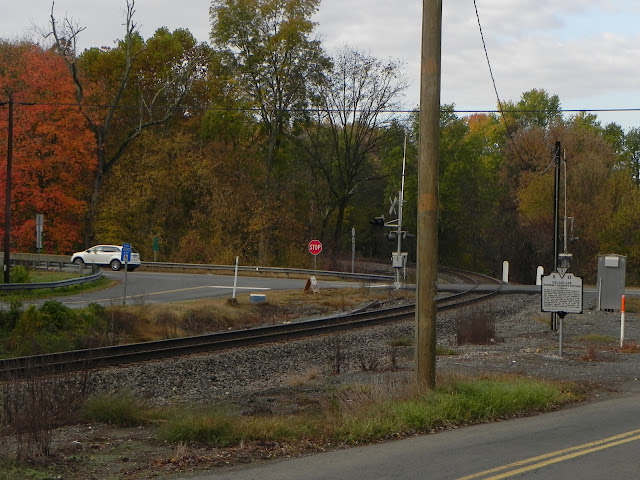This past weekend I decided to take the family for an outing in the countryside. On Saturday morning we put the boys in their car seats, jumped into the SUV, and headed to
Sky Meadows State Park in Fauquier County. My wife and I first visited the park back in 2010. The historic home of Mt. Bleak, located on the grounds of Sky Meadows, has several connections to Mosby's Rangers and the Civil War. (I wrote a post about my previous visit
here.) Of course, I couldn't resist taking a little detour to another Civil War site on the way to Sky Meadows.
Near the confluence of Goose Creek and Crooked Run we pulled off Rt. 17 and stopped at Delaplane. This tiny hamlet, known as Piedmont Station during the Civil War, appears much as it did in the mid-nineteenth century. The Manassas Gap Railroad reached the area in 1852. The company decided to place a new station near the point where the railroad crossed the vital transportation link of the Dumfries-Winchester Road (now Rt. 17). The town grew up around the station, and by the start of the Civil War, had become an important rail center in Fauquier County. Piedmont Station was renamed Delaplane in 1874 and today is designated as a Historic District on the National Register of Historic Places.
 |
| Civil War Trails marker on Delaplane Grade Rd., just to the south of the old Manassas Gap Railroad line. Today the tracks are part of the Norfolk Southern system. |
Piedmont Station played a key role in the First Bull Run Campaign. Gen. Joseph E. Johnston, commander of the Confederate Army of the Shenandoah, received an urgent order on July 18, 1861 to join forces with Gen. P.G.T. Beauregard at Manassas Junction. The general, worried that his volunteer army would take too long to march to Beauregard's assistance, opted instead to send his army by rail. Johnston proceeded to Piedmont Station and oversaw preparations for the transportation of his men to Manassas Junction.
 |
| Close-up of the Civil War Trails marker. (More information can be found here on the Historical Marker Database.) The marker makes the claim that "[h]ere. . . trains were used for the first time in history to move troops to impending battle." |
Meanwhile, Johnston's army was on the move out of the Shenandoah Valley. Gen. Thomas J. Jackson's brigade left the Winchester area around noon on July 18. After marching all day and night, they passed through Ashby's Gap and stopped in Paris at two in the morning of July 19. (Incidentally, I wrote about
Paris and Jackson-related sites a few years ago.) Jackson allowed his men a few hours of rest before they set out to complete the remaining six miles to Piedmont Station. They arrived at six in the morning. Patriotic civilians greeted Jackson's troops at the station and offered them food and drink. Jackson's men, likely basking in the glow of admirers, ate their breakfast and then boarded the train of freight and cattle cars for Manassas. Progress was slow. The 34-mile trip took an incredible eight hours. Jackson, of course, would go on to earn the nickname "Stonewall" on the battlefield of Manassas on July 21.
 |
| Two original railroad buildings dating to 1852. These structures have been used as depots, warehouses, and stores. The National Register of Historic Places Registration Form for Delaplane notes that "[t]he survival of these two large antebellum brick structures associated with the railroad is a rare occurrence in Virginia since few antebellum brick buildings of this scale can be documented anywhere else in Virginia." (p. 16.) |
Despite logistical difficulties, regiments from the brigades of Col. Francis Bartow and Gen. Barnard Bee followed Jackson over the course of the next day or so. The brigade of Col. Arnold Elzey, under the temporary command of Gen. Edmund Kirby Smith, did not leave Piedmont Station until the early morning hours of July 21. The men arrived at Manassas mid-day and marched quickly to the sounds of battle. Elzey's troops smashed into the Federal right on Chinn Ridge and helped to secure the Confederate victory.
 |
| Another view of the antebellum railroad buildings, taken from Rokeby Rd. The railroad line runs in front of the buildings. |
 |
| Looking west down the old Manassas Gap Railroad tracks from Rokeby Rd. in Delaplane. A Virginia State Historical Marker on Piedmont Station and First Manassas sits to the right. (See here for text.) The white SUV is traveling south on Rt. 17, the old Dumfries-Winchester Rd. |
Today Delaplane sits almost untouched by time. You'll find no Starbucks, McDonald's, or strip malls there. It isn't hard to imagine Jackson's troops mounting the rail cars and starting their journey towards Manassas and fame. Walking next to the tracks, I was reminded of the contribution that this village made to modern military history. Railroads played an important part in the Civil War, and Johnston's operation at Piedmont Station stood near the very start of it all. Although the means of transportation proved a little slower than Johnston may have liked, his actions at Piedmont Station demonstrated the value of harnessing railroad technology to military advantage. That's big stuff for such a small place, and well worth a stop to look around and ponder.
Sources
William C. Davis,
Battle at Bull Run (1985 ed.); Bradley M. Gottfried,
The Maps of First Bull Run (2009); Joseph E. Johnston,
Narrative of Military Operations (1874); National Register of Historic Places Registration Form,
Delaplane Historic District (2003); Ethan Rafuse,
A Single Grand Victory: The First Campaign and Battle of Manassas (2002).





2 comments:
We stopped out there this past weekend, nice antique shop and friendly people.
Mike--Glad you enjoyed it. The antiques store was closed when we were there. In any event, a neat little hamlet.
Post a Comment